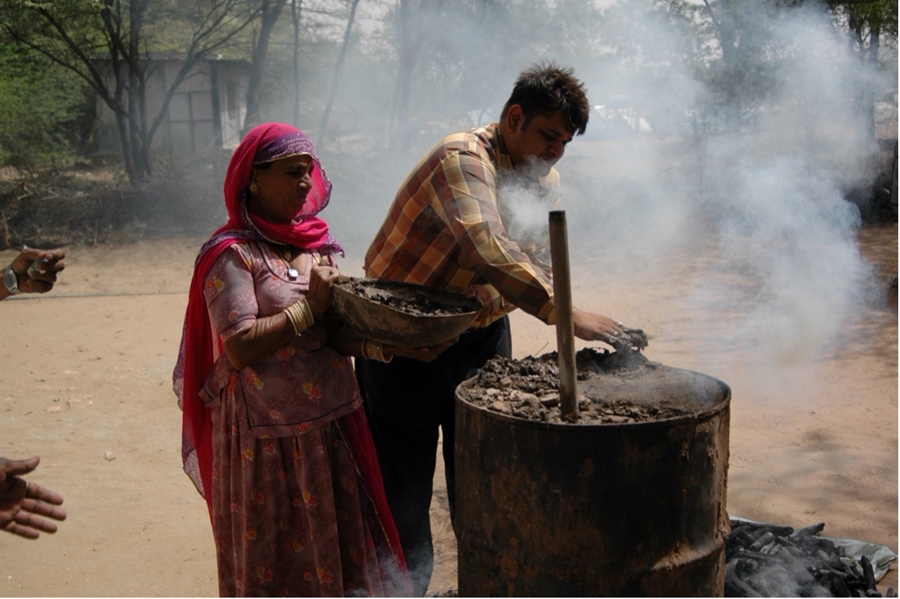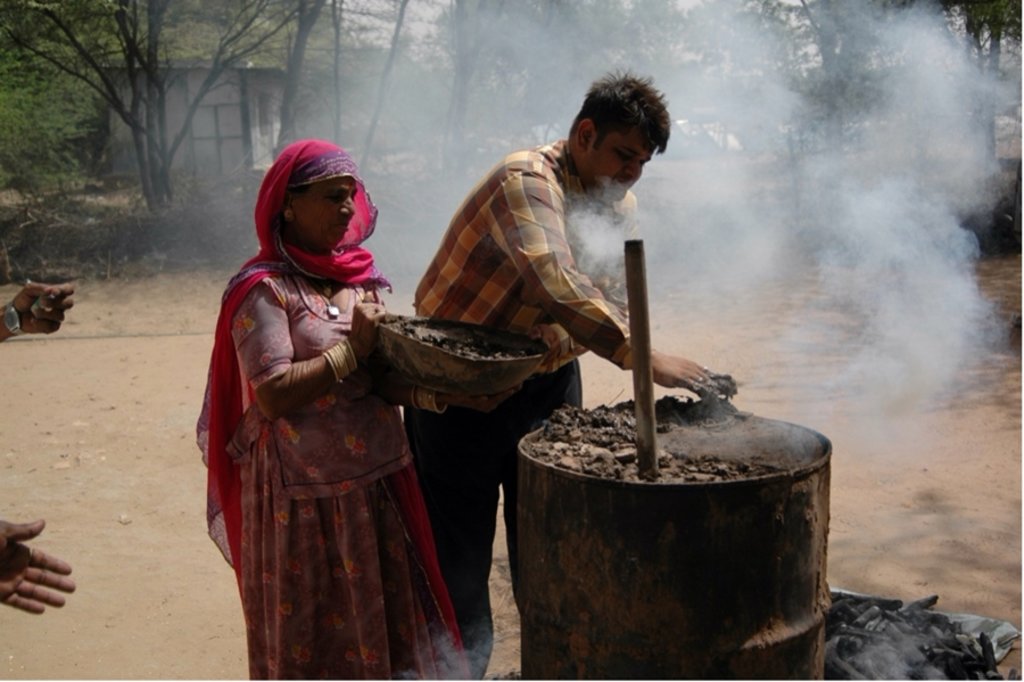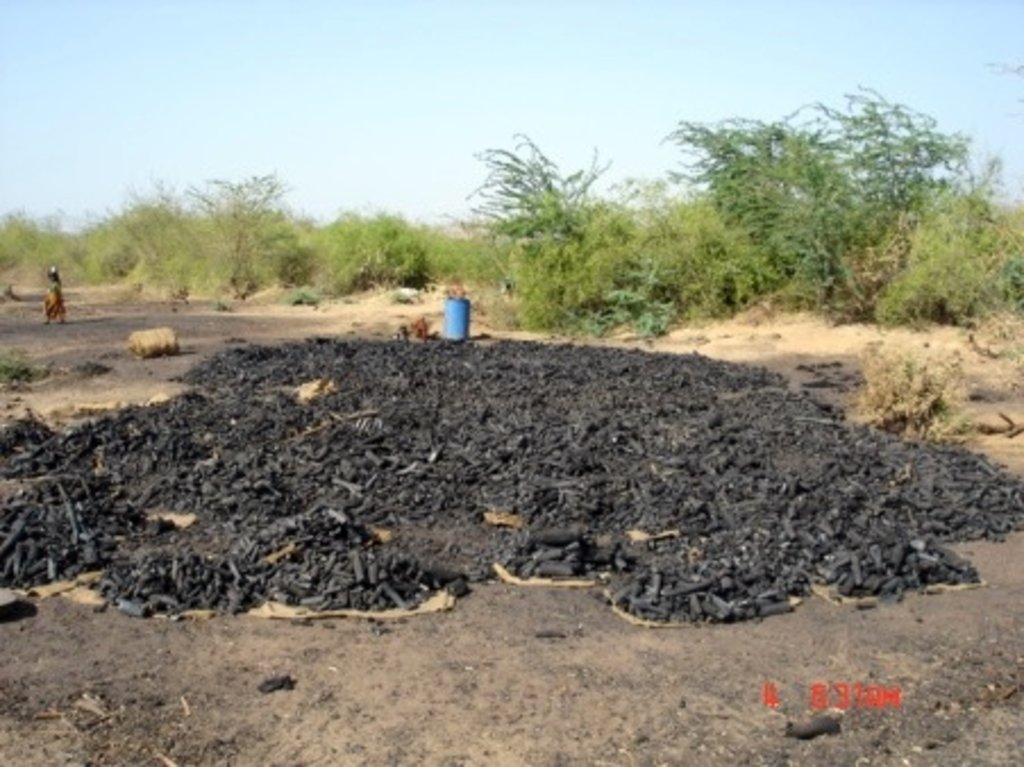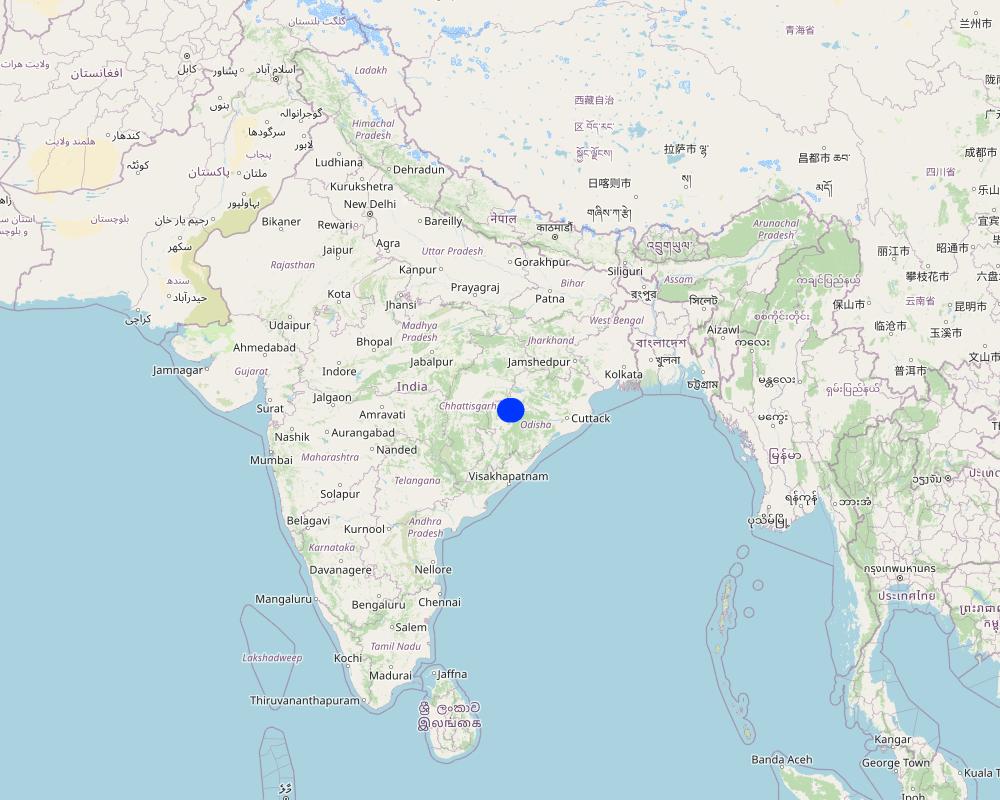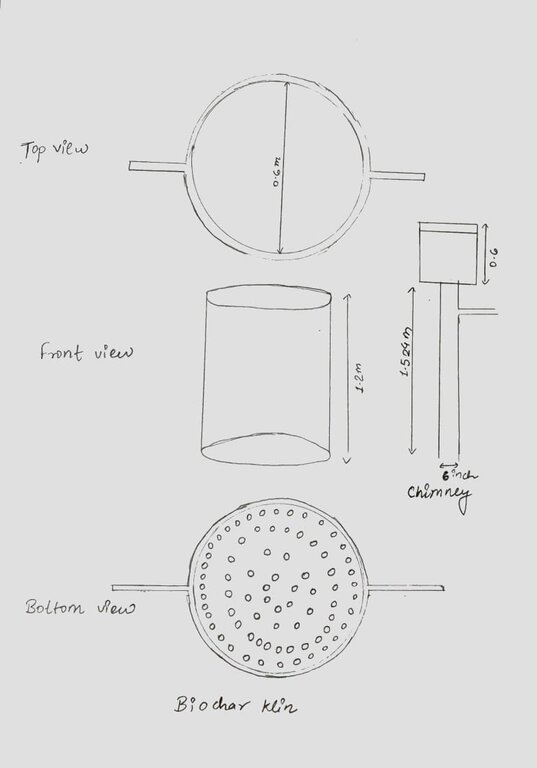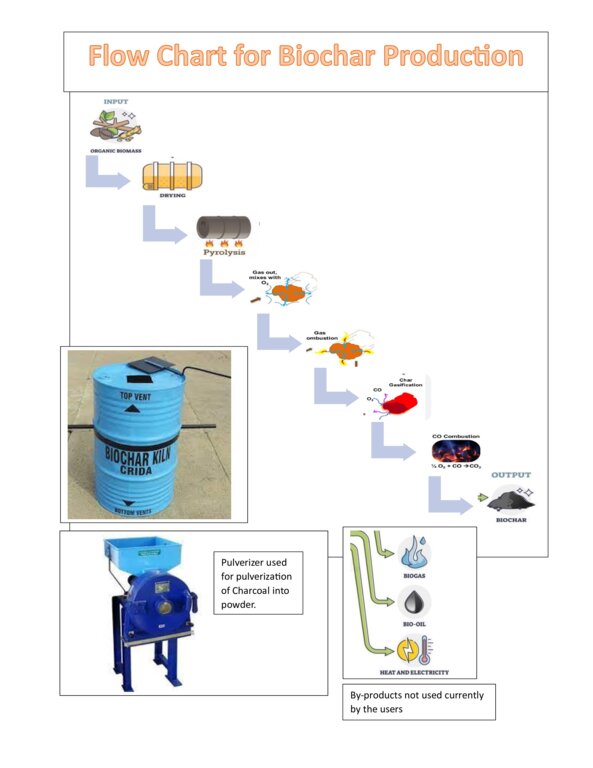Sustainable Biochar Production Through Agroforestry Systems And Its Application [Энэтхэг ]
- Шинийг нээх:
- Шинэчлэх:
- Мэдээлэл цуглуулсан: Santosh Gupta
- Редакторууд: Kim Arora, Stephanie Jaquet, Tabitha Nekesa, Ahmadou Gaye, Siagbé Golli
- Хянагчид: Udo Höggel, Sally Bunning
technologies_6735 - Энэтхэг
Бүлгүүдийг үзэх
Бүгдийг харуулах Бүгдийг хаах1. Ерөнхий мэдээлэл
1.2 Технологийг үнэлэх, баримтжуулах ажилд хамаарах мэдээлэл өгсөн хүмүүс, байгууллагуудын холбоо барих мэдээлэл
Технологи баримтжуулах/үнэлэх ажилд дэмжлэг үзүүлсэн төслийн нэр (шаардлагатай бол)
Soil protection and rehabilitation for food security (ProSo(i)l)Технологи баримтжуулах/үнэлэх ажилд дэмжлэг үзүүлсэн байгууллага(ууд)-ын нэр (шаардлагатай бол)
Deutsche Gesellschaft für Internationale Zusammenarbeit (GIZ) - ГерманТехнологи баримтжуулах/үнэлэх ажилд дэмжлэг үзүүлсэн байгууллага(ууд)-ын нэр (шаардлагатай бол)
International Centre for Research in Agroforestry (ICRAF) - КениТехнологи баримтжуулах/үнэлэх ажилд дэмжлэг үзүүлсэн байгууллага(ууд)-ын нэр (шаардлагатай бол)
Ecociate Consultants (Ecociate Consultants) - Энэтхэг1.3 WOCAT-аар баримтжуулсан өгөгдлийг ашиглахтай холбоотой нөхцөл
Эмхэтгэгч болон гол мэдээлэгч хүн(хүмүүс) WOCAT аргачлалаар баримтжуулсан мэдээллийг ашиглахтай холбоотой нөхцлийг хүлээн зөвшөөрсөн.
Тийм
1.4 Технологи тогтвортой гэдгийг баталгаажуулах
Энэ технологи азрын доройтлыг бууруулахад нөлөө үзүүлэхгүй тул газрын тогтвортой менежментийн технологи болж чадахгүй юу?
Үгүй
Тайлбар:
The application of biochar to the soil is a technology that can prevent or reduce land degradation by improving soil health through the addition of organic matter, increase soil fertility and the water retention capacity of soils.
1.5 ГТМ Арга барилын Асуулга (ууд) руу хандах (WOCAT ашиглан баримтжуулсан)

Developing professional standards in the installation, maintenance and … [Мали ]
Ensure the sustainability of schemes and continuity of production, and reduce production costs
- Мэдээлэл цуглуулсан: Dieter Nill
2. ГТМ Технологийн тодорхойлолт
2.1 Технологийн товч тодорхойлолт
Технологийн тодорхойлолт:
Biochar is a carbon-rich, solid material derived from a wide range of biomass or organic waste through a thermochemical method. It is an organic charcoal material that is the final product of pyrolysis, or high-temperature burning of agricultural biomass without oxygen. Surplus crop residues, agricultural waste, and wood from sustainable sources are used as feedstock (raw material). Such biochar production is linked with agroforestry plantation and agriculture to improve soil health and ensuring sustainable feedstock availability.
2.2 Технологийн дэлгэрэнгүй тайлбар
Тодорхойлолт:
Introduction and Background
Intensive cropping systems coupled with monocropping and high usage of synthetic fertilizers have led to the degradation of soils and depletion of nutrients directly affecting agricultural productivity and farmers' income. Farmers in the Balangir district of Odisha are facing similar challenges. To address these issues and promote sustainable farming practices, a biochar production initiative was introduced by utilizing crop residues and waste material from forests to produce biochar, a carbon-rich material that enhances soil fertility and soil structure. The initiative is a part of the Pro-Soil Project of Deutsche Gesellschaft für Internationale Zusammenarbeit (GIZ), India and implemented by the International Centre for Research in Agroforestry (ICRAF). The technology (a kiln for biochar production) and technical inputs for biochar production were sourced from the Indian Institute of Soil Science, Bhopal.
Biochar is a type of charcoal produced from biomass like agricultural or forest waste or organic materials through a process called pyrolysis. The application of sustainable biochar technology in agroforestry systems can lead to better soil structure, increased water retention, reduced nutrient leaching, and improved crop yields. Moreover, it aids in mitigating greenhouse gas emissions by locking carbon into soil for an extended period.
In the project region farmers used crop residues such as rice straw, wheat straw and residue of other crops along with non-usable biomass from local forests, such as branches, twigs, and leaves, to supplement the feedstock for the pyrolysis. Since the District has large forest areas, the availability of forest waste is no problem. The biochar produced was applied into existing crops fields as well as into agroforestry system. Aiming to promote agroforestry, the project promoted the integration of trees (both fruits and timber) and shrubs into existing agricultural practices. Agroforestry offers multiple benefits such as improved soil health, biodiversity, and carbon sequestration. When sustainable biochar production is integrated into these systems, it can create a sustainable cycle where agricultural waste is converted into biochar, which then enhances soil fertility and sequesters carbon when added back into the soil.
The project has actively involved women farmers, entrepreneurial youth, and farmers' groups in the collection, production and application process of biochar thus promoting community participation and creating awareness about the benefits of biochar.
Implementation
The biochar kiln technology, obtained from the Indian Institute of Soil Science, in Bhopal, is employed to convert biomass into biochar through pyrolysis. This technology ensures efficient and controlled production of high-quality biochar. The collected biomass undergoes a controlled pyrolysis process inside the biochar kiln, where it is burned in the relative absence of oxygen. Technical specialization during production includes kiln temperature control, feedstock preparation, and the management of pyrolysis gases to ensure efficient biochar production. This results in the conversion of biomass into biochar, also leaving behind bioenergy-rich gases. Quality control measures are implemented to ensure the production of biochar with optimal characteristics, including high carbon content, porosity, and stability.
The Biochar kiln used was designed with the aim to optimize temperature control and ensure efficient conversion of biomass. An efficient loading mechanism allows easy and controlled feeding of biomass into the kiln. This ensures a consistent flow of material during the pyrolysis process. Although local kilns are usually not equipped with temperature control mechanisms to regulate the pyrolysis temperature, the temperature in the kilns may alternatively be regulated through the rate of feeding biomass into the kilns. Such kilns usually have some safety features and proper ventilation so to prevent accidents.
To implement this technology the ICRAF conducted training sessions for farmers on the proper preparation and application of biochar. The trainings were focused on the following aspects:
-The collection and drying process for agriculture and forest waste
-The management of operations for the biochar kiln including the loading of raw material (feedstock) into the kiln, its burning, operation-timing, period check, volumes of raw material to be fed etc.
-Precautions to be taken during the process
-The quality check of prepared biochar charcoal and the process for pulverizing it
-Dosage recommendations for different crops as per local conditions
-The mixing of biochar with cow dung and cow urine before application
-Integration with existing farming practices and the long-term benefits of biochar on soil health
Impact and Knowledge Transfer
The biochar acts as a soil conditioner, enhancing water retention, nutrient availability, and microbial activity. The benefits and impacts on improved fertility, increased water retention, and reduced nutrient leaching, lead to higher crop yields and resilience against climate variability, carbon sequestration aids in reducing greenhouse gas emissions, contributing to global efforts to combat climate change, and utilizing agricultural residues reduces air pollution from open burning and provides a sustainable solution for organic waste disposal. Land users appreciated the enhanced soil productivity and environmental benefits brought by biochar. Overall, the Sustainable Biochar Production Technology represents a promising approach in sustainable agriculture and environmental stewardship.
The project team, in collaboration with local agricultural extension services and the Indian Institute of Soil Science, monitored the impact of biochar application on soil health parameters. This involved regular soil testing, crop yield assessments and feedback from participating farmers. In fact, they also measured the impact of biochar made from different feedstock (raw materials). Success stories were shared with neighboring communities, public stakeholders and researchers and encouraged the further adoption of sustainable soil management practices.
The biochar production initiative in the Balangir District of Odisha in India demonstrates a sustainable approach to addressing soil health issues using locally available resources. Through the collaboration between ICRAF and GIZ, this project not only improves soil fertility but also empowers local communities by providing them with sustainable solutions for agricultural challenges. The success of this intervention serves as a model for future initiatives aimed at promoting environmentally friendly and community-driven approaches to agriculture.
2.3 Технологийн гэрэл зураг
2.4 Технологийн дүрс бичлэг
Тайлбар, товч тодорхойлолт :
https://www.youtube.com/watch?v=qHpIPVX2mR8&t=8s
Байршил :
Bhopal, MP
Зураглаачийн нэр :
ICAR-CIAE
2.5 Энэ үнэлгээнд хамрагдсан технологийг хэрэгжүүлсэн улс орон / бүс нутаг / байршил
Улс :
Энэтхэг
Улс/аймаг/сум:
Odisha
Технологи өргөн дэлгэрсэн эсхийг тодорхойл:
- тодорхой газар хэрэгжсэн/ жижиг талбайд төвлөрсөн
Технологи(иуд) нэвтрүүлсэн талбай байнгын хамгаалалттай газар нутагт байрладаг уу?
Үгүй
Map
×2.6 Хэрэгжих огноо
Хэрэгжүүлсэн он:
2021
2.7 Технологийн танилцуулга
Технологийг хэрхэн нэвтрүүлснийг тодорхойл:
- Туршилт/судалгааны үр дүн
- Гадны төсөл/хөтөлбөрийн дэмжлэгтэйгээр
Тайлбар (төслийн төрөл г.м.):
Piloting best practices to produce biochar using diverse feedstock and its application
3. ГТМ технологийн ангилал
3.1 Технологийн үндсэн зорилго (д)
- Үйлдвэрлэлийг сайжруулах
- Газрын доройтлыг бууруулах, сэргийлэх, нөхөн сэргээх
- Экосистемийг хамгаалах
- Биологийн төрөл зүйлийг хамгаалах / сайжруулах
- Уур амьсгалын өөрчлөлт/ эрс тэс байдал болон түүний нөлөөлөлд дасан зохицох
- Үр ашигтай эдийн засгийн нөлөөг бий болгох
3.2 Технологи хэвтрүүлсэн газрын одоогийн газар ашиглалтын хэлбэр(д)
Нэг газр нутгийн хэмжээнд хэрэгжих холимог газар ашиглалт:
Үгүй

Тариалангийн газар
- Нэг наст үр тариа
- Мод, бут тариалах
Тариалан - Таримлыг тодорхойлно уу:
- үр тариа - шар будаа
- үр тариа - цагаан будаа (өндөр газрын)
Мод, бут тариалах - Таримлыг тодорхойлно уу:
- тэжээлийн модлог ургамал (Calliandra, Leucaena leucocephala, Prosopis, бусад)
- жимс, бусад
Нэг жил дэх ургамал ургах улирлын тоо:
- 2
Тодорхойлно уу:
Mostly farmers are cultivating during the monsoon season as these are the rainfed farmers. Some farmers with irrigation facilities are cultivating in winter season as well
Сөөлжлөн тариалалт хийгддэг үү?
Тийм
Хэрэв тийм бол ямар таримлыг сөөлжлөн тариалдаг вэ?
Millets and other cereals
Таримлыг ээлжлэн тариалдаг уу?
Тийм
Хэрэв тийм бол, тодруулна уу:
Cereals, Pulses, Fodder crops

Байгалийн ой / модтой газар
- (Сайжруулсан) байгалийн ой/мод бүхий газар
(Хагас)байгалийн ой/тармаг ойд: Менежментийн төрлийг тодорхойлно уу:
- Хатсан мод/мөчрийг авах
Дээр дурьдсан модны төрөл навч, шилмүүсээ гөвдөг үү эсвэл мөнх ногоон уу?
- холимог нөвч, шилмүүсээ гөвдөг/мөнх ногоон
Бүтээгдэхүүн ба үйлчилгээ:
- Мод бэлтгэл
- Түлшний мод
- Жимс, самар
- Бэлчээрийн талбай/Хариулгатай бэлчээрлэлт

Суурьшил, дэд бүтэц
- Хот суурин, барилга
3.3 Технологи хэрэгжүүлснээс газар ашиглалтад өөрчлөлт гарсан уу?
Технологи хэрэгжүүлснээс газар ашиглалтад өөрчлөлт гарсан уу?
- Үгүй (3.4 хариулт руу шилжинэ үү)
3.4 Усан хангамж
Технологи хэрэгжүүлсэн газрын усан хангамж:
- Байгалийн/усалгаа хосолсон
Тайлбар:
Most farmers are cultivating in rainfed conditions while some also have irrigation facilities
3.5 Технологи ГТМ-ийн аль бүлэгт хамаарах
- гадаргын/ ургамал бүрхэвч сайжрах
- Ус хураах
- Хог хаягдлын менежмент / хаягдал усны менежмент
3.6 Технологийг бүрдүүлэх ГТМ арга хэмжээ

Агрономийн арга хэмжээ
- А1: Ургамал/ хөрсөн бүрхэвч
- А2: Органик нэгдэл/ хөрсний үржил шим
- А3: Хөрсний гадаргыг сайжруулах
- А6: Хагд өвсний менежмент

Ургамалжилтын арга хэмжээ
- V4: Харийн/ түрэмгий зүйлийг солих, зайлуулах
- V5: Бусад

Менежментийн арга хэмжээ
- M6: Хог хаягдлын менежмент (дахин боловсруулах, эргүүлэх ашиглах эсвэл бууруулах)

Бусад арга хэмжээ
Тодорхойлно уу:
Climate resilient soil management by application of biochar using varied feedstock (rwa material) generated through agroforestry
3.7 Технологийн шийдвэрлэсэн газрын доройтлын үндсэн төрлүүд

Хөрс усаар эвдрэх
- Wt: Хөрсний гадаргын угаагдал

Хөрсний физик доройтол
- Ps: Органик хөрсний хомсдол

Биологийн доройтол
- Bl: Хөрсөн дэхь амьдрал алдагдах
3.8 Газрын доройтлоос урьдчилан сэргийлэх, сааруулах ба нөхөн сэргээх
Газрын доройтолтой холбоотойгоор Технологи ямар зорилго тавьсан болохыг тодорхойл:
- Газрын доройтлыг багасгах сааруулах
- Хүчтэй доройтсон газрыг нөхөн сэргээх/ сайжруулах
4. Техникийн нөхцөл, хэрэгжилтийн үйл ажиллагаа, материал ба зардал
4.1 Технологийн техникийн зураг
Техник тодорхойлолт (техник зурагтай уялдана):
The single barrel biochar klin was developed by the Indian Institute of Soil Sciences in Bhopal (IISS). The Kiln had already been designed and commercialised by the IISS. Land users can buy a metallic kiln unit from the IISS or get it fabricated from local fabricators based on the design specifications suggested in the drawing.
Зохиогч:
Payal Dewangan
Он, сар, өдөр:
12/07/2023
Техник тодорхойлолт (техник зурагтай уялдана):
The flowchart provides a step by step guide for biochar production in the project area by land users
Зохиогч:
Payal and Santosh
Он, сар, өдөр:
20/11/2023
4.2 Материал болон зардалд хамаарах ерөнхий мэдээлэл
Үнэ өртөг, оруулсан хувь нэмрийг хэрхэн тооцсоныг тодорхойл:
- Технологийн нэгж тус бүр
Нэгжийг тодорхойл:
200 L capacity
Нэгж хэмжигдэхүүний хэмжих нэгжийн тодорхойлох (шаардлагатай бол):
Litre
бусад/үндэсний мөнгөн нэгж (тодорхойл):
INR
Хэрэв боломжтой бол үндэсний валютын Америк доллартай харьцах харьцааг бичнэ үү (тухайлбал, 1 ам.дол. = 79,9 Бразил реал): 1 ам.дол. =:
80.0
Хөлсний ажилчны нэг өрдийн ажлын хөлсийг тодорхойл:
204 Rupees
4.3 Байгуулах үйл ажиллагаа
| Үйл ажиллагаа | Хугацаа (улирал) | |
|---|---|---|
| 1. | Purchase of biochar kiln unit | Can be done any time during the year but need to be ready before the month of September |
| 2. | Purchase of pulveriser | Need to be purchased once and before the start of biochar production |
Тайлбар:
Both biochar kiln and pulveriser are fixed investments and can last up to 5 years
4.4 Байгуулалтад шаардагдах зардал ба материал
| Хөрөнгө оруулалтыг дурьдана уу | Хэмжих нэгж | Тоо хэмжээ | Нэгжийн өртөг | Материал бүрийн нийт өртөг | % газар ашиглачаас гарсан зардал | |
|---|---|---|---|---|---|---|
| Тоног төхөөрөмж | Biochar Klin | Rs. | 1.0 | 7000.0 | 7000.0 | |
| Тоног төхөөрөмж | Pulvariser unit | Rs. | 1.0 | 20000.0 | 20000.0 | |
| Технологи бий болгох нийт үнэ өртөг | 27000.0 | |||||
| Технологи бий болгох нийт үнэ өртөг, ам.доллар | 337.5 | |||||
Хэрэв газар ашиглагчаас нийт өртөгийн 100%хүрэхгүй зардал гарсан бол хэн үлдсэн хөрөнгө оруулалтыг хийснийг тодорхойл.
The project paid towards the fixed investment costs of biochar kiln and pulverizier unit
4.5 Засвар үйлчилгээ / давтагдах үйл ажиллагаа
| Үйл ажиллагаа | Хугацаа/ давтамж | |
|---|---|---|
| 1. | Collecting the crop residues and forest waste | Needs to be collected and dried before the start of biochar production unit (September and June) |
| 2. | Preparation of Biochar | Before the sowing of Rabi (winter) and Kharif (summer) seasons (Months of September/October and June/July) |
| 3. | Application of biochar in the field | During the cropping season |
Тайлбар:
These activities may vary based on the cropping pattern and farmers' need of biochar application
4.6 Засвар үйлчилгээ / урсгал үйл ажиллагаанд шаардагдах зардал ба материал (жилээр)
| Хөрөнгө оруулалтыг дурьдана уу | Хэмжих нэгж | Тоо хэмжээ | Нэгжийн өртөг | Материал бүрийн нийт өртөг | % газар ашиглачаас гарсан зардал | |
|---|---|---|---|---|---|---|
| Хөдөлмөр эрхлэлт | Preparation of biochar | Person-day | 2.0 | 200.0 | 400.0 | 100.0 |
| Хөдөлмөр эрхлэлт | Application of biochar in the field | Person-day | 1.0 | 200.0 | 200.0 | 100.0 |
| Бордоо ба биоцид | Farmyard manure | Rs. | 20.0 | 5.0 | 100.0 | 100.0 |
| Бордоо ба биоцид | Fertilizer | Rs. | 50.0 | 7.0 | 350.0 | 100.0 |
| Технологийг арчилах тордоход шаардагдах нийт үнэ өртөг | 1050.0 | |||||
| Технологи сайжруулах нийт үнэ өртөг, ам.доллар | 13.13 | |||||
Тайлбар:
The application of biochar was practiced by land users twice in a year, before sowing kharif and rabi crops. The amount of maintenance activities of the technology is count double for a year as farmers are practicing the biochar technology for two seasons in a year.
4.7 Зардалд нөлөөлж байгаа хамгийн чухал хүчин зүйл
Өртөг зардлыг тодорхойлох гол хүчин зүйлсийг дурьдана уу:
The investment towards the purchase of the kiln- and the pulveriser unit. In the documented project, the investment costs were borne by the project. Therefore, smallholder farmers may find it difficult to purchase the hardware units of kiln and pulveriser, given such investment costs.
5. Хүн, байгалийн хүрээлэн буй орчин
5.1 Уур амьсгал
Жилийн нийлбэр хур тундас
- <250 мм
- 251-500 мм
- 501-750 мм
- 751-1,000 мм
- 1,001-1,500 мм
- 1,501-2,000 мм
- 2,001-3,000 мм
- 3,001-4,000 мм
- > 4,000 мм
Жилийн дундаж хур тунадас (хэрэв мэдэгдэж байвал), мм:
1288.00
Суурь болгон авсан цаг уурын станцын нэр:
Bhubaneshwar, Odisha
Агро-уур амьсгалын бүс
- Хагас чийглэг
The District is located under the West Central Table Land Agro Climatic Zone characterized by hot and sub-humid climate
5.2 Байрзүйн зураг
Дундаж налуу:
- Тэгш (0-2 %)
- Бага зэрэг хэвгий (3-5 %)
- Дунд зэрэг хэвгий (6-10 % )
- Долгиорхог (11-15 %)
- Толгодорхог (16-30 %)
- Эгц налуу (31-60 % )
- Огцом эгц налуу (>60 %)
Гадаргын хэлбэр:
- Тэгш өндөрлөг/тэгш тал
- Зоо, хяр
- Уулын энгэр, хажуу
- Ухаа, гүвээ, дов толгод
- Уулын бэл
- Хөндий, хоолой, нам хотос
Өндөршлийн бүс:
- 0-100 м д.т.д
- 101-500 м д.т.д
- 501-1,000 м д.т.д
- 1,001-1,500 м д.т.д
- 1,501-2,000 м д.т.д
- 2,001-2,500 м д.т.д
- 2,501-3,000 м д.т.д
- 3,001-4,000 м д.т.д
- > 4,000 м д.т.д
Технологи дараах асуудалд хандсан эсэхийг тодорхойл:
- шаардлагагүй
Гадаргын талаархи тайлбар ба бусад тодорхойлолт:
Balangir District is divided into four Agro-Ecological situations (AES) and characterized by a hot dry summer and highly erratic rainfall distribution of south-west monsoon rains, i.e., (i) plain land irrigated, (ii) plain land rainfed (iii) undulating plain drought-prone and (iv) undulating sub-mountainous tract rainfed.
The altitude of the Bolangir district is 207 masl.
5.3 Хөрс
Хөрсний дундаж зузаан:
- Маш нимгэн (0-20 см)
- Нимгэн (21-50 см)
- Дунд зэрэг зузаан (51-80 см)
- Зузаан (81-120 cм)
- Маш зузаан (>120 cм)
Хөрсний бүтэц (өнгөн хөрс):
- Сийрэг/хөнгөн (элсэрхэг)
- Хүнд (шаварлаг)
Хөрсний бүтэц (>20 см-ээс доош):
- Сийрэг/хөнгөн (элсэрхэг)
- Хүнд (шаварлаг)
Өнгөн хөрсний органик нэгдэл:
- Бага (<1 % )
Боломжтой бол хөрсний бүрэн тодорхойлолт, боломжит мэдээллийг өгнө үү, жишээ нь хөрсний төрөл, хөрсний урвалын орчин/хүчиллэг байдал, катион солилцох чадавхи, азотын хэмжээ, давсжилт г.м.
Mixed red and yellow soils occur as catenary associations in undulating and rolling terrains which differ in depth, texture, and color. Red and yellow soils are moderately shallow in depth and coarse-textured. Upland soils are shallower and lighter in texture than low-land soils.
Red and black soils are light to medium textured having neutral pH. These soils occur in mixed forms of both red & black soil together in which black soils occur in patches within the predominant red soils.
Black soils are mostly found in Puintala Block and in some parts of Loisingha Block. The soils are heavier in texture having clay content more than 30%. Clay minerals are predominant with smectites due to which deep cracks are seen to develop during summer.
Laterite soils are generally distributed in a few limited patches in the Balangir District. These soils are loamy sand to sandy loam in the surface having a hard clay pan in the subsoil. Crusting is a problem in upland literite.
Brown forest soils are mostly found in Khaprakhol, Tureikela, Bangomunda, Titilagarh, Saintala, and Gudvella Block. These soils are brown to grey-brown in color, light textured, and acidic in reaction.
5.4 Усны хүртээм ба чанар
Хөрсний усны гүн:
5-50 м
Гадаргын усны хүртээмж:
Сайн
Усны чанар (цэвэрлээгүй):
Муу чанарын ундны ус (цэвэршүүлэх шаардлагатай)
Усны чанар гэж:
гадаргын болон ул хөрсний ус
Усны давсжилт асуудал болдог уу?
Тийм
Тодорхойлно уу:
Balangir District falls within the Western Plateau and Hills Zone of Odisha, characterized by a semi-arid climate. The agro-climatic conditions include hot summers, limited rainfall, and erratic monsoons, which pose challenges for agriculture due to water scarcity. In many regions of Odisha, including Balangir, water salinity is a significant concern, especially in areas relying on groundwater sources.
Энэ газар үер усанд автдаг уу?
Үгүй
Усны чанар, нөөцийн талаархи тайлбар ба бусад тодорхойлолт:
The groundwater level at 3 meters below ground level in 2019 indicates water table that lies within 3-5 meters below ground level (m bgl) or less is considered shallow. This level often indicates good accessibility to groundwater, making it relatively easier for extraction using shallow wells or hand pumps.
5.5 Биологийн төрөл зүйл
Зүйлийн олон янз байдал:
- Их
Амьдрах орчны олон янз байдал:
- Их
Биологийн олон янз байдлын талаархи тайлбар ба бусад тодорхойлолт:
The Odisha Government has declared the Gandhamardan Hill Range in Bargarh and Balangir Districts a Biodiversity Heritage Site (BHS).
5.6 Технологи нэвтрүүлсэн газар ашиглагчидын онцлог шинж
Үйлдвэрлэлийн системийн зах зээлийн чиг баримжаа:
- Амь зуух арга хэлбэрийн (өөрийгөө хангах)
Фермээс гадуурх орлого:
- Нийт орлогын %10 доош хувь
Чинээлэг байдлыг харьцангуй түвшин:
- Ядуу
Хувь хүн эсвэл бүлэг:
- Хувь хүн / өрх
- бүлэг / олон нийтийн
Механикжилтын түвшин:
- Хүнд хүчир ажил
- Амьтны зүтгүүр
Хүйс:
- Эмэгтэй
- Эрэгтэй
Газар ашиглагчийн нас:
- Залуус
- Дунд нас
Газар ашиглагчдын бусад шаардлагатай шинж чанарыг тодорхойл:
There are a number of women self help groups and farmer producer organisations being formed in the district as part of Government programs
5.7 Технологи нэвтрүүлэхэд газар ашиглагчийн ашигласан газрын дундаж талбай
- < 0.5 га
- 0.5-1 га
- 1-2 га
- 2-5 га
- 5-15 га
- 15-50 га
- 50-100 га
- 100-500 га
- 500-1,000 га
- 1,000-10,000 га
- > 10,000 га
Энэ нь жижиг, дунд, том оворт тооцогдох уу (орон нутгийн чиг баримжаагаар)?
- Бага-хэмжээний
5.8 Газар эзэмшил, газар ашиглах эрх, ус ашиглах эрх
Газар өмчлөл:
- Хувь хүн, цол эргэм бүхий
Газар ашиглах эрх:
- Хувь хүн
Ус ашиглах эрх:
- Нэгдлийн хэлбэрээр (зохион байгуулалттай)
- Хувь хүн
Газар ашиглалтын эрх уламжлалт эрхзүйн тогтолцоонд суурилдаг уу?
Үгүй
Тайлбар:
The majority of the farmers in the district are smallholder farmers with agriculture being mostly rained, except some areas with irrigation facilities from the nearby dam
5.9 Дэд бүтэц, үйлчилгээний хүртээмж
эрүүл мэнд:
- Ядуу
- Дунд зэргийн
- Сайн
боловсрол:
- Ядуу
- Дунд зэргийн
- Сайн
техник дэмжлэг:
- Ядуу
- Дунд зэргийн
- Сайн
хөдөлмөр эрхлэлт (жишээ нь, ХАА-аас өөр):
- Ядуу
- Дунд зэргийн
- Сайн
зах зээл:
- Ядуу
- Дунд зэргийн
- Сайн
эрчим хүч:
- Ядуу
- Дунд зэргийн
- Сайн
зам ба тээвэр:
- Ядуу
- Дунд зэргийн
- Сайн
ундны ус ба ариутгал:
- Ядуу
- Дунд зэргийн
- Сайн
санхүүгийн үйлчилгээ:
- Ядуу
- Дунд зэргийн
- Сайн
Тайлбар:
The district is located in the interior parts of eastern India and considered as a backward district with poor access to infrastructure and other facilities
6. Үр нөлөө ба дүгнэлт
6.1 Технологийн талбай дахь үр нөлөө
Нийгэм-эдийн засгийн үр нөлөө
Үйлдвэрлэл
Газар тариалангийн үйлдвэрлэл
Тайлбар/ тодорхой дурьдах:
For Wood Biochar or Wood Coconut Husk Biochar (WCB), or Crop Residue Biochar (CRB) the highest grain yield of the crop was recorded with the highest dose of biochar, fertilizer, and manure application. Also, it's application significantly improved the straw yield
үр тарианы чанар
Тайлбар/ тодорхой дурьдах:
The application of Wood Biochar or Wood Coconut Husk Biochar (WCB), or Crop Residue Biochar (CRB) with manure also significantly improved the quality of the crop
тэжээл үйлдвэрлэл
Тайлбар/ тодорхой дурьдах:
It was found with significantly improved straw yield the availability of fodder for the livestock also increased
тэжээлийн чанар
Тайлбар/ тодорхой дурьдах:
It was recorded that the quality of the crop also the quality of the straw also improved.
үйлдвэрлэл зогсох эрсдэл
Тайлбар/ тодорхой дурьдах:
It was observed that the crop in which the application of biochar was with the manure and fertilizer, the crop had better adaptation and standing properties in comparison to another crop without the application of biochar.
газрын менежмент
Орлого, зарлага
тариалангийн газрын орлого
Тайлбар/ тодорхой дурьдах:
The yield for the crop in which application was done was increased which led to an increase in income
Нийгэм-соёлын үр нөлөө
хүнсний аюулгүй байдал/ өөрийгөө хангах
Экологийн үр нөлөө
Усны эргэлт/ илүүдэл
ус хураах / цуглуулах
Тайлбар/ тодорхой дурьдах:
Water retention from the soil increased because of the increase in soil organic matter and carbon content
гадаргын урсац
Тайлбар/ тодорхой дурьдах:
The water holding capacity of the water increased leading to less surface runoff from the field.
ууршилт
Хөрс
хөрсний чийг
Тайлбар/ тодорхой дурьдах:
With an increase in soil organic matter and improved soil texture the soil moisture increased
хөрс алдагдах
Тайлбар/ тодорхой дурьдах:
The semi-arid climate and limited rainfall, combined with sporadic and intense monsoons, can lead to soil erosion. When rainfall does occur, it can cause rapid runoff, carrying away the topsoil due to the lack of vegetation cover or inadequate soil conservation measures.
шимт бодисын эргэлт/ сэргэлт
Тайлбар/ тодорхой дурьдах:
The application of biochar with manure and fertilizers not only increased the nutrients in the soil but also increased the nutrient uptake of plants from the soil.
давсжилт
Тайлбар/ тодорхой дурьдах:
Biochar can act as a soil amendment to moderate soil pH depending on the initial pH level. Scientifically, biochar tends to be pH neutral, so its impact on soil pH depends on the existing soil condition. The impact of biochar on pH is often gradual and depends on various factors like the type and composition of biochar, soil characteristics and environmental conditions. Biochar acts more as a buffer, stabilizing soil pH over time rather than making drastic immediate changes.
хөрсний органик нэгдэл/ хөрсөнд агуулагдах С
Биологийн: ургамал, амьтан
Ургамал бүрхэвч
Тайлбар/ тодорхой дурьдах:
The plant biomass as well as the vegetative growth of the plant showed a significant positive reaction to the biochar application on crops
газрын дээрхи / доорхи С
ургамлын төрөл, зүйл
хортон шавж/өвчний хяналт
Тайлбар/ тодорхой дурьдах:
Resistance of the crop increases with better uptake of K from the soil. Plants become more resistant to disease and pests.
Уур амьсгал болон гамшгийн эрсдлийг бууруулах
нүүрстөрөгч ба хүлэмжийн хийн ялгаруулалт
Талбай дахь буюу on-site үр нөлөөний үнэлгээг тодорхойлно уу (хэмжилт):
In the context of regions like Balangir, where salinity and soil loss are concerns, biochar's ability to improve soil structure and fertility without altering pH drastically could be beneficial. It helps mitigate soil erosion by enhancing soil health and resilience, thus contributing to sustainable agriculture practices in these challenging environments.
6.3 Технологийн уур амьсгалын өөрчлөлт ба Уур амьсгалаас хамаарах аюул/гамшигт үзэгдэлд өртөх байдал ба эмзэг байдал (газар ашиглагч нарын дүгнэлтээр)
Уур амьсгалын аажим өөрчлөлт
Уур амьсгалын аажим өөрчлөлт
| Улирал | Өсөх эсвэл буурах | Технологи түүний нөлөөг хэрхэн бууруулж байна? | |
|---|---|---|---|
| Жилийн дундаж температур | Өсөлт | Дунд зэрэг | |
| Улирлын температур | Зун | Өсөлт | Дунд зэрэг |
| Жилийн дундаж хур тундас | Бууралт | Сайн | |
| Улирлын хур тундас | Чийглэг/борооны улирал | Бууралт | Дунд зэрэг |
Уур амьсгалаас хамаарах аюулууд (гамшигууд)
Уур амьсгалын гамшигууд
| Технологи түүний нөлөөг хэрхэн бууруулж байна? | |
|---|---|
| Ган гачиг | Дунд зэрэг |
Тайлбар:
Overall biochar improves the soil health and helps soil to maintain the moisture thus it is better suited to some of the climatic conditions such as low rainfall, delayed rains etc. However in case of extreme climatic conditions, technology alone may not mitigate the impact.
6.4 Зардал ба үр ашгийн шинжилгээ
Үр ашгийг барилга байгууламжийн зардалтай (газар ашиглагчдын үзэл бодлоор) хэрхэн харьцуулах вэ?
Богино хугацаанд эргэн төлөгдөх байдал:
Эерэг
Урт хугацаанд эргэн төлөгдөх байдал:
Маш эерэг
Үр ашгийг засвар үйлчилгээ/ урсгал зардалтай (газар ашиглагчдын үзэл бодлоор) хэрхэн харьцуулах вэ?
Богино хугацаанд эргэн төлөгдөх байдал:
Маш эерэг
Урт хугацаанд эргэн төлөгдөх байдал:
Маш эерэг
Тайлбар:
The benefits of technology to soil health, crop productivity and crop quality is much higher than the cost of establishment and maintenance
6.5 Технологи нутагшуулах
- жишээ/ туршилт
Боломжтой бол, тоогоор илэрхийл (өрхийн тоо эсвэл бүрхэх талбай):
100
Технологийг өөрийн талбайд нэвтрүүлсэн бусад иргэдээс хэд нь үүнийг өөрийн хүчээр, өөрөөр хэлбэл ямар нэг материал, техникийн дэмжлэг, төлбөр авалгүй хийсэн бэ?
- 0-10%
Тайлбар:
It was mostly done as part of the PRO-SOIL PROJECT
6.6 Дасан зохицох
Хувьсан өөрчлөгдөж буй нөхцөл байдалд Технологид сүүлд ямар нэг шинэчлэл хийгдсэн үү?
Тийм
Хэрэв тийм бол ямар өөрчлөлтийг даван туулахад шинэчлэл хийгдсэн бэ?
- Ажил хөдөлмөр эрхлэх боломж (ж.нь шилжих хөдөлгөөний улмаас)
Технологийн дасан зохицох байдлыг тодорхойл (хийц, материал, төрөл зүйл г.м.):
Refinements in pyrolysis methods and technologies to produce biochar with specific characteristics suited to diverse soil types and climate conditions. This includes adjusting temperature, duration, and feedstock to optimize biochar properties like porosity and water retention capacity. Innovations in application techniques to improve the efficiency and effectiveness of biochar incorporation into agricultural systems. This involves exploring precision application methods, such as localized placement or mixing with organic amendments, to ensure better distribution and utilization of biochar in the root zone. Emphasis on integrating biochar technology into climate-smart agricultural practices, focusing on sustainable intensification while adapting to changing climatic conditions. This involves promoting practices that enhance resilience to drought, water conservation and soil fertility improvement.
6.7 Технологийн давуу тал/боломжууд
| Газар ашиглагчдын тодорхойлсон давуу тал/боломжууд |
|---|
| The soil moisture, soil texture, water retention and water-holding capacity of the soil increases. The uptake of nutrients increases which leads to less application of fertilizers in the field |
| There was an increase in crop yield, straw yield, vegetative mass growth, more grains or fruits per plant, and fewer pests & disease attacks on the plants were noticed |
| The better use of crop residue from the field increase the soil fertility and promoted better crop growth |
| Эмхэтгэгч, бусад мэдээлэл өгсөн хүмүүсийн өнцгөөс тодорхойлсон давуу тал/боломжууд |
|---|
| The use of biochar helps to combat the climate crisis by sequestering atmospheric carbon into soil as well as processing agricultural and other waste into useful clean energy |
| The application of biochar significantly changes the soil’s properties (texture, porosity, bulk density, particle density, surface area, pore size distribution, cation exchange capacity, pH, and water-holding capacity) which, directly influence plant growth |
| High porosity and a large surface area of biochar provide space for micro-organisms that are beneficial for the soil and help in binding important anions and cations, improving soil health and enhancing crop productivity |
| Reduced nitrous oxide and methane emissions when biochar is applied to the soil |
6.8 Технологийн дутагдалтай/сул тал/аюул болон тэдгээрийн хэрхэн даван туулах арга замууд
| Газар ашиглагч нарын тодорхойлсон сул тал/ дутагдал/ эрсдэл | Тэдгээрийг хэрхэн даван туулах вэ? |
|---|---|
| Need large quantities of wood and crop residue for biochar production on a larger scale |
A better planning for crop residue management and access to communities to collect forest waste from forest can easily address this problem Exploring alternative biomass sources like agricultural residues, crop waste, or dedicated energy crops can reduce reliance on wood or coconut shells, promoting sustainable sourcing. Also, advancements in pyrolysis technologies to optimize biochar production from smaller quantities of biomass, improving efficiency and reducing the overall demand. |
| Do not have knowledge about how this biochar can be sold in the market for additional income |
Creating more awareness among the farmers about biochar will create a market demand for it. Conducting market assessments and creating awareness among potential buyers about the benefits of biochar for soil improvement, carbon sequestration, and agricultural productivity. Exploring the development of value-added products or applications derived from biochar, such as soil amendments, filtration systems, or compost blends, to diversify market opportunities. |
| Эмхэтгэгч, бусад мэдээлэл өгсөн хүмүүсийн өнцгөөс тодорхойлсон сул тал/ дутагдал/ эрсдэл | Тэдгээрийг хэрхэн даван туулах вэ? |
|---|---|
| The availability of suitable wood and coconut for biochar production can be limited, and there may be competition between biochar production and other uses of biomass, such as food and fuel production | The innovation in technology where biochar can be produced with lesser amount of feedstock will be a great solution |
| If not managed sustainably, the production of biomass feedstock for biochar can lead to deforestation or the conversion of natural ecosystems into monoculture plantations, which can have negative ecological consequences |
The promotion of agro-forestry is important to ensure the availability of feed stock while also ensuring the increased coverage of forest. The training of land users and other stakeholders around sustainable biochar production. |
7. Ном зүй ба холбоосууд
7.1 Мэдээллийн аргууд / эх сурвалжууд
- Газар ашиглагчтай хийсэн ярилцлага
4
- ГТМ-ийн мэргэжилтэн/шинжээчтэй хийсэн ярилцлага
3
- тайлан болон бусад эх сурвалжийн бүрдэл
5
Мэдээллийг хэзээ (газар дээр нь) цуглуулсан бэ?
07/07/2023
7.2 Хүртээмжтэй ном, бүтээлийн ишлэл
Гарчиг, зохиогч, он, ISBN:
IBI publication at International Biochar Initiative
Хаанаас авч болох вэ? Зардал?
https://biochar-international.org/resources/ibi-publications/
7.3 Холбогдох мэдээллийн интернет холбоос
Гарчиг/ тодорхойлолт :
About Balangir District
URL:
https://balangir.nic.in/about-district/
Гарчиг/ тодорхойлолт :
Water Resources of Balangir District (Minor Irrigation Division, Balangir)
URL:
https://balangir.nic.in/water-resources/
Гарчиг/ тодорхойлолт :
Senior Geologist, Ground Water Survey & Investigation Division, Balangir
URL:
https://www.rtiodisha.gov.in/Pages/printAllManual/office_id:2710/lang:
7.4 Ерөнхий мэдээлэл
This documentation not only follows the land user interview findings but also follows the results mentioned in the internal report after the experimentation
Холбоос ба модулууд
Бүгдийг харуулах Бүгдийг хаахХолбоосууд

Developing professional standards in the installation, maintenance and … [Мали ]
Ensure the sustainability of schemes and continuity of production, and reduce production costs
- Мэдээлэл цуглуулсан: Dieter Nill
Модулууд
Модуль байхгүй байна


